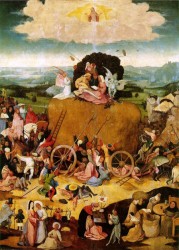
Salazar 1955
“El Bosco y Ambrosio de Morales” (Abdon M. Salazar) 1955
[in: Archivo Español de Arte, T.° XXVIII (1955), no. 110, pp. 117-138]
[Also mentioned in Gibson 1983: 38 (C37)]
In 1948 Juan de Contreras published a Spanish description of Bosch’s Haywain, coming from Teatro moral de la vida humana, a Spanish edition from 1701 (see De Contreras 1948). The third part of this book has a description of and comment on the Tabla de Cebes, a painting from Antiquity, and added to this is a description of and comment on the Haywain. According to the anonymous author the themes of these two paintings are very much alike. Salazar now reports that the author of this text is the Spanish historian Ambrosio de Morales (1513-1591) and that the text was already published in 1586. In that year Morales’ Obras del maestro Fernàn Pérez de Oliva (Córdoba, Gabriel Ramos Bejarano, 1586) was published. The Hellenist Fernàn Pérez de Oliva (1492/93-1531) was Morales’ uncle and Morales added a few of his own texts to to the works of his relative, among them the descriptions of the Tabla de Cebes and the Haywain. In this article Salazar edits the text about the Haywain, using the 1586 edition (pp. 124-126).
In the foreword to the reader of the 1586 edition Morales points out that he wrote the text about the Tabla de Cebes when he was still a young man. According to Salazar this was probably when he studied at the university, circa 1530. An argument against this could be that in 1586 Morales writes that the Haywain was owned by Philip II, but it is possible that this detail was adapted when the text was published.
Ambrosio de Morales was well acquainted with Felipe de Guevara y Lastre (circa 1500-1563) who wrote his Comentarios de la pintura in 1560-62 (not published until 1788), in which some paragraphs are devoted to Bosch. Circa 1544/45 Morales was for some time the tutor of Diego de Guevara y Haro, a son of Felipe, and after Felipe’s death Morales was one of the negotiators when Philip II purchased a number of paintings from the De Guevara’s in 1570. One of these paintings was a Haywain by Bosch.
Felipe had inherited this Haywain in 1520, from his father Diego de Guevara y Queseda (major-domo of Charles V), after a trial with his uncle Pedro Vélez de Guevara that was won by Felipe. In 1535 Felipe married Beatriz de Haro, after which he moved to Madrid (where his eldest son Diego was born in 1538, he would die in 1565). In 1570 the Haywain was still located in Felipe’s house in Madrid, after which the painting was purchased by Philip II and transported to the Escorial. Circa 1530 this Haywain was already owned by Felipe and that is probably how Morales knew about the triptych back then.
It is hard to underrate the importance of this article, if only for the publication of Morales’ text about the Haywain, which is an art-historical document of the highest interest (a Dutch translation of Morales’ text in De Bruyn 2001a: 37-38). Furthermore, this article signals that the relationship between the De Guevara’s and Bosch is in urgent need of closer research.
[explicit 28th August 2011]